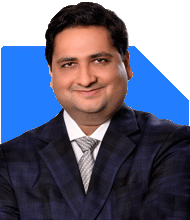Hardik Parikh | Answer |Ask -Follow
Tax, Mutual Fund Expert - Answered on Apr 19, 2023
He also holds an MBA degree from IIM-Indore.
Hardik, who began his career as an equity research analyst, founded his own advisory firm, Hardik Parikh Associates LLP, which provides a variety of financial services to clients.
He is committed to sharing his knowledge and helping others learn more about finance. He also speaks about valuation at different forums, such as study groups of the Western India Regional Council of Chartered Accountants.... more

Hi, I am investing 24,000 as a SIP in following MF schemes since 2020. 1. HDFC Taxsaver - 5000 2. HDFC retirement saving - 2000 3. Mirae asset large cap fund - 3000 4. Axis small cap fund - 2000 5. Axis mid cap fund - 2000 6. Axis bluechip fund - 2000 7. Franklin india feeder - US Opp fund - 2000 8. Quant active fund - 3000 9. Parag Parikh flexi cap fund - 3000 Please advise if I need to make any adjustments. I want to make corpus of 1 CR by 2030.
It's great to see that you've been disciplined with your investments since 2020. Your portfolio comprises a mix of tax-saving, retirement, large-cap, mid-cap, small-cap, and international funds, which is a good sign of diversification.
Considering your goal of accumulating a corpus of ₹1 crore by 2030, let's look at your current investment approach and see if any adjustments are needed.
First, let's assume an average annual return of 12% on your investments, which is reasonable for equity-oriented mutual funds in the long term. With your current monthly SIP of ₹24,000, you will have invested ₹2,88,000 annually. By 2030, which is 7 years away, you would have invested ₹20,16,000 in total.
Using the assumed 12% annual return, the future value of your investment by 2030 would be approximately ₹33,38,000. This is significantly short of your ₹1 crore goal.
To achieve your target, you would need to increase your monthly SIP amount. Here's what you can do:
Review your financial situation and identify any areas where you can increase your monthly investments. You may need to invest around ₹50,000 per month to achieve ₹1 crore by 2030, assuming the same 12% annual return.
Reassess your portfolio and its asset allocation. While your current allocation seems well-diversified, it's important to ensure that it's aligned with your risk tolerance and investment horizon. You may need to make some changes to improve the potential for higher returns. Consider discussing this with a financial advisor to ensure your portfolio is optimized for your goals.
Regularly review your investments and their performance. It's essential to keep track of how your mutual funds are performing compared to their benchmark indices and peers. If you find any underperformers, consider replacing them with better-performing alternatives.
Remember that investing is a long-term journey and requires patience, discipline, and regular reviews. It's important to stay committed to your investment plan and make adjustments as needed to reach your financial goals.
Wishing you the best on your journey to ₹1 crore by 2030!
Warm regards,
You may like to see similar questions and answers below
Hemant Bokil | Answer |Ask -Follow
Financial Planner - Answered on Mar 21, 2023
Ramalingam Kalirajan |10870 Answers |Ask -Follow
Mutual Funds, Financial Planning Expert - Answered on Apr 12, 2024
Ramalingam Kalirajan |10870 Answers |Ask -Follow
Mutual Funds, Financial Planning Expert - Answered on May 05, 2024
Ramalingam Kalirajan |10870 Answers |Ask -Follow
Mutual Funds, Financial Planning Expert - Answered on May 11, 2024
Ramalingam Kalirajan |10870 Answers |Ask -Follow
Mutual Funds, Financial Planning Expert - Answered on Oct 03, 2024
Dr Shyam Jamalabad |107 Answers |Ask -Follow
Dentist - Answered on Dec 05, 2025
Dr Shyam Jamalabad |107 Answers |Ask -Follow
Dentist - Answered on Dec 05, 2025
Dr Dipankar Dutta |1836 Answers |Ask -Follow
Tech Careers and Skill Development Expert - Answered on Dec 05, 2025
Ulhas Joshi |280 Answers |Ask -Follow
Mutual Fund Expert - Answered on Dec 05, 2025
Dr Dipankar Dutta |1836 Answers |Ask -Follow
Tech Careers and Skill Development Expert - Answered on Dec 04, 2025
Ravi Mittal |676 Answers |Ask -Follow
Dating, Relationships Expert - Answered on Dec 04, 2025
Anu Krishna |1745 Answers |Ask -Follow
Relationships Expert, Mind Coach - Answered on Dec 04, 2025
Anu Krishna |1745 Answers |Ask -Follow
Relationships Expert, Mind Coach - Answered on Dec 04, 2025
Mayank Chandel |2562 Answers |Ask -Follow
IIT-JEE, NEET-UG, SAT, CLAT, CA, CS Exam Expert - Answered on Dec 04, 2025
Mayank Chandel |2562 Answers |Ask -Follow
IIT-JEE, NEET-UG, SAT, CLAT, CA, CS Exam Expert - Answered on Dec 04, 2025



























